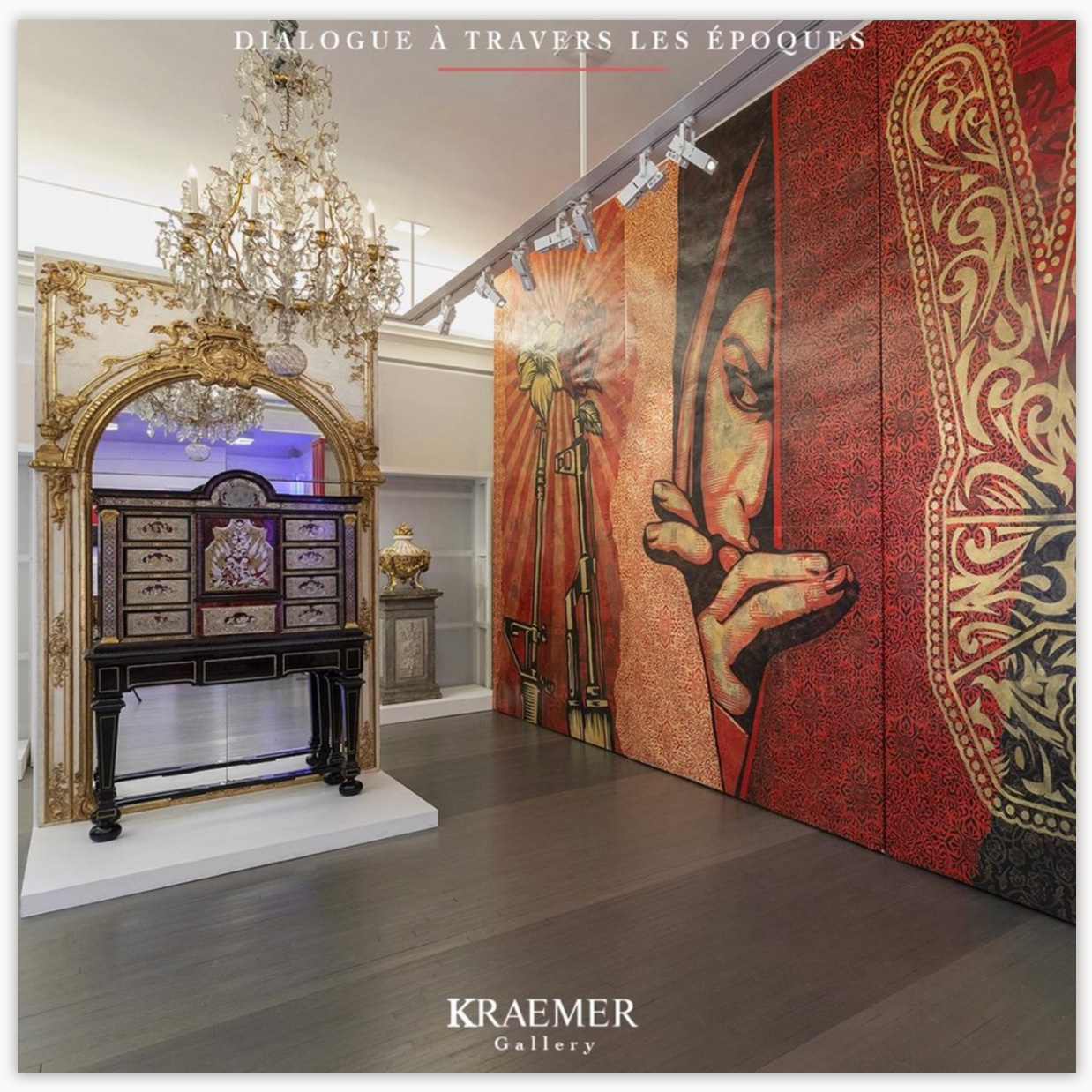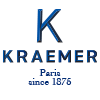A DIALOGUE ACROSS CENTURIES
War: a universal subject explored by artists across four centuries.
Kraemer Gallery loves mixing different styles. This collection features eclectic modern and contemporary artworks that are paired with pieces from the Kraemers’ area of predilection: 18th century furniture and works of art. We chose to display a four-panel painting by Obey and a Louis XIV marquetry cabinet.
Shepard Fairey, also known as Obey, is one of the most famous street artists of our time.
He made his debut with a street art campaign in 1989. He called it “André the Giant Has a Posse” and renamed it “Obey Giant” in 1998. The work of art that made him famous was the “Hope” poster he made during the American presidential campaign in 2008 to demonstrate his endorsement of Barack Obama. Obey expresses himself through collages, posters and urban graffiti.
His frescos adorn various cities like Paris, where he crafted an artwork that showcases the French motto to commemorate the November 2015 terror attack. His work reflects his commitment to peace. He aims to show that there is meaning and intention behind any artwork.
In 2009, he showed his political commitment through “Middle East Mural”, one the largest canvases he ever created. It was painted with warm red and brown tones and features symbols that convey a universal message of peace. He made this as an act of protest against the wars that are raging in the Middle East; the artwork depicts guns loaded with flowers. He also painted the V symbol with his fingers.
“War is the link between the gallery’s two main artworks.”
The cabinet displays military scenes and was made with tortoiseshell, tin and bronze marquetry.
The cabinetmaker and merchant Henry Van Soest is thought to be the artist who created this Louis XIV cabinet. It features painted scenes representing military dancers and musicians during bivouacs, military meetings where battle plans were discussed, battlefields and a besieged fortress surrounded with artillery. They were all painted on a tortoiseshell base. This reddish material helped the craftsman create a contrast: he was able to make the characters and their movements stand out with intimate detail. The warmth of the material is reminiscent of the colours Obey used in his four-panel painting. He used the marquetry technique to create the first and second layers of this cabinet, just like André-Charles Boulle in France, who used the same technique during the same time period.
The two artworks seem to be interacting through the young woman depicted by Obey. She hides behind curtains, and her suspicious gaze indicates that she is curious about something. This Northern European cabinet is probably not something this Eastern young woman is used to seeing; it is very different from the art forms she is used to. The Arabic and Muslim influences that permeate Obey’s artwork perfectly match the originality of 17th century craftsmen.
“Both artworks were displayed next to each other during the “Urban Revolution” exhibition that was organised in collaboration with Magda Danysz, from October 15 2018 to January 31 2019.”
The exhibition featured artworks by numerous famous street artists whose work is still widely acclaimed: Banksy, Invader, Retna and André Saraïva.
In this exhibition, we tried to analyse what makes these artists so talented, and we attempted to show what their techniques have brought to art history. In the 1980s, their work started to evolve. They stopped using letters and included icons and logotypes. Obey decided to paint faces on walls. This new style is now part of his unique trademark.
These new artists had such an impact on street art that the movement broke free from graffiti and implemented new concepts in order to raise awareness about important issues.
Jean Holthausen is a Parisian cabinetmaker from German descent. He obtained his degree in 1764.
He worked during the Regency, during Louis XV’s reign, and during the Transition period. Since he got his degree later in life, few of his pieces of furniture were stamped. His works of art denote a keen interest in marquetry details, such as flowers and cubes. His love of lacquer from the Far East, which he used on plated and veneer pieces, makes him stand out.
Coromandel lacquers were invented in China in the early 17th century. The English named them this because they used to load East India Company ships with lacquers along the East Indian coast. Thin layers of wood were covered with fabric and placed on top of each other. They were held together with vegetable glue. The resulting lacquer was painted and decorated with carved patterns.
These lacquers used to adorn large cabinets and screens. European craftsmen would dismantle them and add the lacquers to fashionable pieces of furniture. Lacquered panels were used to decorate chests of drawers, corner pieces and other pieces of furniture.
This Coromandel lacquered chest of drawers shows how much European countries used to like Oriental aesthetics. This was the case in France, which was deeply influenced by haberdashers since the beginning of Louis XV’s reign in 1730. Artists would extract lacquer from imported pieces of furniture. They would then refine them and transfer them onto their own furniture pieces. Once they had added them to the new piece, they crafted delicate gilded bronze settings for them.
This chest of drawers is a beautiful example of Holthausen’s style, which is a reflection of its time: the craftsman added lacquer to a black piece of furniture in order to create a harmonious piece that remained faithful to the panel’s former aesthetics.
The slightly rounded exterior highlights the characters that were painted on the lacquered panels. Delicate bronze-coloured ornaments can be found on the lines, on the locks and on the handles. Their Louis XV-inspired curves and counter-curves emphasise the delicate lines on the chest of drawers. The black-veined marble top adds a final touch to the piece and its delicate mouldings complement the artwork’s shape.
In Holthausen’s work, lacquered pieces of furniture are rare: this chest of drawers is a unique work of art.
Ébéniste parisien d’origine allemande, Jean Holthausen obtient sa maîtrise en 1764.
Son œuvre couvre les mouvements Régence, Louis XV et Transition, mais ayant obtenu sa maîtrise tardivement, peu de ses meubles sont estampillés. Ses réalisations révèlent une préférence pour les marqueteries de fleurs, de cube, d’attributs et il se démarque par un attrait pour les laques d’Extrême-Orient sous forme de placage.
Les laques dits « de Coromandel » ont été mis au point à partir du XVIIè siècle en Chine. Elles ont été nommées ainsi par les Anglais, en référence à la côté orientale de l’Inde où étaient chargées les laques sur les navires de la Compagnie des Indes. La technique du laque est la superposition de fines couches de bois recouvertes de tissu maintenues entre elles par de la colle végétale. Le laque obtenu était ensuite peint et décoré de motifs par de profondes incisions.
Ces laques décoraient à l’origine des cabinets et des paravents de grande taille qui étaient ensuite démontés par les artisans européens afin de les appliquer sur les meubles à la mode. C’est ainsi que des panneaux de laque se sont retrouvés sur les commodes, encoignures et autres meubles.
Cette commode en laque de Coromandel reflète le goût pour l’Orient des pays occidentaux et particulièrement de la France dès 1730 à partir du règne de Louis XV, sous l’influence des marchands-merciers. Ils prélevaient le laque sur les meubles importés qu’ils affinaient ensuite pour les plaquer sur le bâti de leur meuble. Une fois intégrés au meuble, ces laques recevaient des montures en bronze doré finement ciselées.
A travers cette commode, Holthausen réalise un magnifique exemple de la pratique de son temps où l’artisan décide d’apposer le laque sur un meuble de couleur noire afin de créer un ensemble harmonieux et respectueux de l’esthétique originelle du panneau.
La forme légèrement bombée de la façade donne vie aux personnages dépeints sur les panneaux de laque. Les bronzes se retrouvent discrètement en chutes, en lignes de chute, en sabots, en entrées de serrure et en poignées. Ils viennent définir et rehausser les lignes très délicates de la commode par leurs jeux de courbes et contre-courbes dignes du style Louis XV. Le dessus de marbre noir veiné vient sommer l’ensemble et souligner le galbe du meuble par sa mouluration délicate.
Les meubles ornés de laque sont rares dans l’œuvre de Holthausen, ce qui fait de cette commode un modèle unique en son genre.


